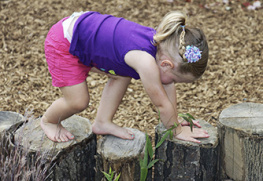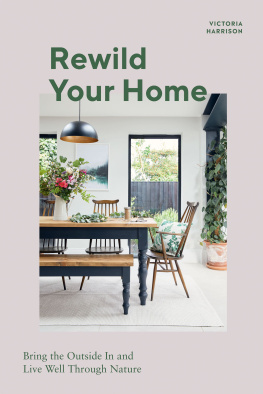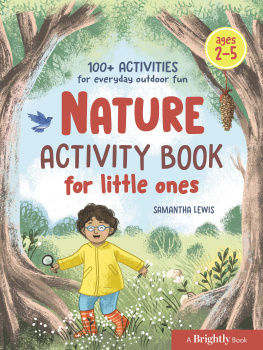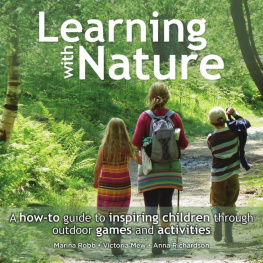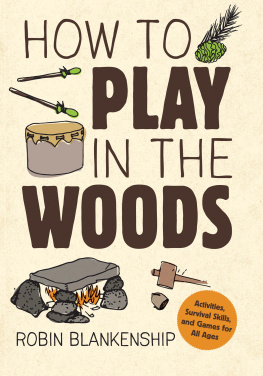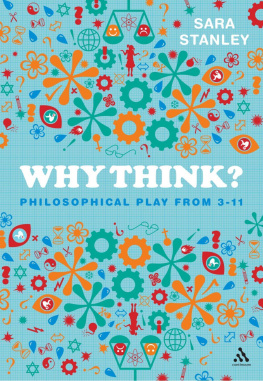Nature Play at Home
Creating Outdoor Spaces that Connect Children with the Natural World
Nancy Striniste Founder of EarlySpace
Illustrations by Jennifer Ren
Dedicated to all my teachers
both children and adults
who taught me the power of spaces and places.
Contents
Introduction
The key is to understand what nourishes our children and use this awareness to inform every step of the design process.
from the Child Care Design Guide, by Anita Rui Olds
Childhood has changed.
When you think back to your own childhood (especially if you are of a certain age), you probably remember spending a lot of time outdoors, roaming free, climbing trees, building stuff, and mucking in mud.
Childrens lives have become more structured and supervised. Many kids spend a great deal of time in front of screens and much less time than past generations playing outside. Academic pressures and parental fears are just two of the reasons for this shift. Depending on where a family lives, fears may be based on real danger outside the door, or created by media that escalates unrealistic worries. Many parents are afraid to allow their children outside unattended, and too busy to accompany them as often as needed. Distance or traffic can make access to play places difficult, which further separates children from these essential experiences of unstructured activity outside in nature.
To illustrate this dilemma, consider a 2007 report by Dr. William Bird, published by Natural England and the Royal Society for the Protection of Birds. It compared four members of a family, each in a different generation, and their outdoor experiences at age 8. When George, the great-grandfather, was 8 years old in 1926, he walked everywhere because his family could not afford a bike for him. He regularly walked six miles on his own to his favorite fishing spot. In 1950, when the grandfather was 8 years old, he walked a mile on his own to play in the woods, and also walked to school. The mother was an 8-year-old in 1979, and was allowed to ride her bike throughout the neighborhood and to the local pool, a half-mile away. Edward, an 8-year-old in 2007, was driven the short distance to school and taken by car to a safe place to ride his bicycle. He was allowed to go about 300 yards to the end of his block on his own, but often didnt enjoy that because there were no other children outside. Edward took piano lessons and skiing lessons and had a trampoline and jungle gym in his yard.
Humans have an innate need to seek connections with nature and other forms of life. E.O. Wilson called this drive biophilia. When this drive is denied, and children dont have the opportunity to form essential relationships with the natural environment, there are consequences for childrens physical and mental health and for their anxiety and stress levels. Thanks to Richard Louv, who gathered all the pieces and first presented them so compellingly in his book Last Child in the Woods (2005), we now have a term that describes what many of todays children experience. Louv called it nature deficit disorder, and by naming it, he launched a worldwide movement and a basis for critical conversations.
An exploding body of research tells us that time in nature is crucial to healthy human development. It improves the bodys overall health and reduces allergies, anxiety, and symptoms of ADHD. It boosts confidence, creativity, and cooperation as children play. Time in nature also encourages active play, which reduces obesity. There is even evidence that nearsightedness is reduced and test scores are improved when children spend more time outdoors in nature.
It is heart-wrenching to see the limits placed on play in so many ways and in so many places. Recess has been shortened and is non-existent in some schools. Covenants at condos and in subdivisions limit play to sterile spaces, and parks prohibit tree climbing. But there is, I believe, reason to be encouraged. On many fronts, the pendulum is swinging back.
Across the country and around the world, committed mothers and fathers, along with educators, caregivers, and policymakers, are working to provide more recess and require less sitting time. Many parents have made a conscious decision to reduce scheduled extracurricular activities, wanting their children to spend more time in nature. Families are organizing nature clubs, and there is a growing number of forest schools and adventure playgrounds popping up across the United States.
For me, as a designer in this field for more than thirty years, the swing is evidenced by the growing number of inquiries I get from families, schools, early childhood programs, and municipalities, all looking to provide nearby places where their children can play in nature.
This book is intended as a guide to help you as a parent understand, advocate for, and bring nature play to your neighborhoodwhether it is in your local park, your childrens schoolyard, common spaces in your community, or your own backyard. Ive had the opportunity to create some wonderful backyard play spaces, working with my crew of top-notch landscape professionals. The cost of a professionally designed space is sometimes out of reach for a young family, but that doesnt mean you cant have a place to play in nature. My hope is to support families in their efforts to create their own natural backyard play spaces. Some families, especially those living in densely built cities, dont have their own backyard to transform, so they turn to shared spaces. Im often approached by parents who want to make change happen at their childs school or childcare center. Sometimes it is a group of parents who have joined together to form a committee through their PTA or board and want to transform their schools outdoor space. But it can also be a lone parent, who knows the outdoor area at his or her childs school could be better for students, and is determined, despite an initial lack of institutional support, to make change happen.

Free-range kids in Stockholm, Sweden, perhaps drawn by the natural elements of water and trees in this park. Seeing children unaccompanied by adults, roaming on their own, stopping to chat and play is a rare sight in American cities today. Weve discovered that children losing their outdoor freedom comes at a cost.

People of all ages need a connection to nature to be happy, healthy, and to think clearly and creatively.

Its never too early to help children discover the natural world around them.

Trails are great for luring young explorers outside.

